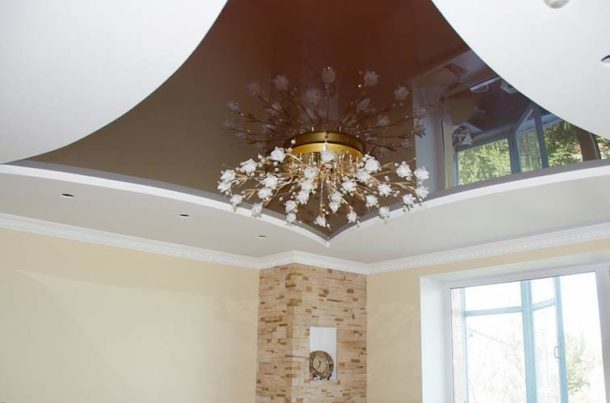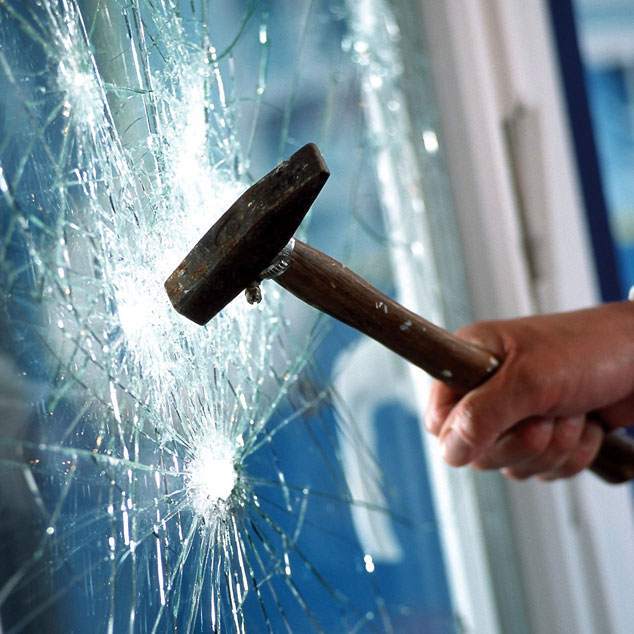Content
- Types of combined ceiling structures
- How to choose a canvas for a combined stretch ceiling
- Use of textile and film cloth in combined ceilings
- How to make a combined ceiling with your own hands
- Preparing a room for installation of a combined ceiling structure
- Materials and Tools
- Combined ceiling installation
- Installation of a film cloth
- Textile installation
Combined plasterboard and stretch ceiling ceilings, photos of which are presented below, have won huge popularity due to the relatively low cost of materials and the ability to create an exclusive interior. It is permissible to use different configurations, two-three-level designs, bold color combinations. With the help of combined ceilings it is possible to zoning the premises and realize multifunctional lighting with point sources of light and LED strips, ceiling and pendant lights. Sophisticated ceiling structures are mounted in living rooms, bedrooms, nurseries, hallways, corridors.

Types of combined ceiling structures
Combined ceilings - from drywall and suspended - are distinguished by a variety of designs:
- a combination of a GKL design with a stretch ceiling;
- a combination of drywall with two or more tension fragments;
- a combination of a stretch ceiling with elements of suspended structures;
- complex ceiling construction, combining several suspended and tension fragments.

How to choose a canvas for a combined stretch ceiling
One of the main tasks of the correct installation of the combined ceiling is stretch web selection. At the same time, factors such as:
- room functionality;
- ceiling size;
- type of construction (single-level, multi-level).
You must select the type of ceiling surface:
- matte;
- glossy;
- satin.

Use of textile and film cloth in combined ceilings
Textile stretch ceilings are characterized by durability, fire resistance, environmental friendliness, high operational characteristics, excellent appearance, but they are only matte and quite limited in terms of colors and invoices. Drywall and stretch ceilings made of textile canvas look great in the living room, study, bedroom of a typical Khrushchev, creating in the apartment a special atmosphere of exquisite luxury and homeliness.
HELPFUL INFORMATION:Drywall guide: how to fix, dimensions and prices

A glossy surface with a variety of patterns, stars, patterns, photo prints, 3D photographs is created only when using film stretch canvases. The combined two-level ceiling made of drywall and film stretch canvas is especially advantageous looks in the interiors of a nursery, living room, bedroom, hallway, kitchen, bathroom of a large apartment with high the ceilings. A striking effect can be achieved by combining a textile fabric with a film.

How to make a combined ceiling with your own hands
The combined ceiling of drywall and stretch fabric can be done by yourself, after preparing a sketch drawing and purchasing the necessary materials and tools. A sketch drawing is important for the correct calculation of the quantity of materials and the designation of complex elements, especially for two-level ceilings with complex configurations of stretch fabric inserts - ovals, circles, ellipses, curved paths.
Tip: in a small living room it is better not to get carried away by the abundance of decorative elements. The elegant simplicity of one large rectangle or square of a stretch will look much more advantageous. ceiling framed by a narrow box of drywall, pasted over with wallpaper or painted to match the wall coatings.

Preparing a room for installation of a combined ceiling structure
Before installing the combined ceiling of drywall and stretch fabric, you need to prepare the room:
- remove furniture, curtains, lamps, wall and ceiling decor;
- remove wallpaper, paint, whitewash, plaster;
- cover cracks, cracks, irregularities with cement-based putty;
- apply a primer layer to increase the waterproofing properties of the ceiling and reduce dust formation.
How to make a sketch drawing:
- make measurements of the room;
- On a large sheet of paper, schematically draw a reduced rectangle or square (depending on the particular room). If there are problem areas in the room — built-in closets, corners, pipes — display them in a diagram;
- mark the zones and distribute the insertion points of the tension elements in the form of geometric shapes, straight, broken and rounded lines, stripes;
- mark the places for spot lighting and basic lighting devices, since the holes for mortise lamps should be drilled before installing a suspended ceiling made of gypsum plaster;
- mark the ceiling and walls according to the drawing.
HELPFUL INFORMATION:How to make a drywall niche with your own hands

Materials and Tools
To install the combined ceiling you will need:
- drywall;
- film or fabric canvas stretch ceiling;
- metal profile;
- drill;
- screws, dowels;
- screwdriver;
- heat gun;
- nylon construction cord;
- thread for marking the ceiling;
- hydro or laser level;
- sandpaper;
- building rule;
- spatulas of different sizes;
- cement and finishing putty, primer, paint;
- self-adhesive sickle;
- baguettes for film canvases;
- respirator and goggles.

Combined ceiling installation
To make the drywall part of the combined ceiling, you need:
- To mount metal frame.
- Attach it to the ceiling along the marking lines.
- Sum up wiring to the places of installation of lamps.
- Sheathe the frame with drywall, fixing the sheets with self-tapping screws screwed in every 0.3 m. Deepen the head of the self-tapping screw into the lining.
- Close the vertical parts of the box with strips of drywall, secure with screws.

Curvilinear structures are made by bending metal profiles.
- Paste over the joints of drywall with walls with a serpentine net.
- Using a small trowel, putty the gaps and places of fastenings with putty.
- Mark on the drywall the location of the fixtures and drill holes if they were not made in advance.
- Apply a layer of finishing putty on the surface of the box.
- When the putty dries, sand the surface.
- Use a damp cloth to remove fine dust resulting from the work.
- Apply an additional coat of primer to improve adhesion and protective properties of drywall.
- Cover the dried surface with acrylic paint or wallpaper.

Installation of a film cloth
Proceed to installation of the canvas it is possible after drying of paint or glue. Experts recommend the use of film ceilings with a harpoon type of fastening, which are easily dismantled if the installation is unsuccessful. Textiles with fastening of this type do not exist.
- The film web is installed in a room heated to + 40 ° C, and during installation, the temperature rises to + 60 ° C. In an unheated room, it will not be possible to tension the film qualitatively. When pulling, a heat gun is used, the work with which requires certain skills.
HELPFUL INFORMATION:How to make do-it-yourself drywall ceilings

- The film is attached to baguettes mounted on the vertical sides of the GKL box, using a harpoon, stretched in the opposite direction and fixed under the baguettes. Care must be taken to prevent wrinkles from appearing on the film surface. You can iron the canvas with a building hair dryer, without bringing it closer to the ceiling by less than 20 cm.
Tip: when working with a film with a glossy or mirror surface, you need to wear gloves so as not to leave fingerprints and palms.

Textile installation
Combining GCR with a textile canvas, you must:
- fasten the profile for clip-on fixing of the web along the perimeter of the box;
- fix the canvas in the center and stretch evenly to the corners;
- fasten fabric in baguettes and corners;
- carefully cut off excess parts of the canvas;
- smooth the textile fragment with a building hairdryer.
Installation of the combined ceiling is an extremely laborious process requiring skills of such work and patience. An unsuccessfully mounted design will have to be reinstalled, which will require additional costs, therefore it is better to trust the professionals, and for many years the ceilings will delight you with an excellent view without spending on repairs.

EXPERT SITE
Tsugunov Anton Valerevich
Master Station Wagon
- Since 2003, I have been engaged in the repair and decoration of premises.
- Over 100 completed objects.
- I appreciate the quality, more than the quantity!
Personal page >>>
Friends!
I offer you the service "Friend Builder"
As this site develops, subscribers and visitors are turning to me more and more often asking for help with advice on various issues of repair and decoration.
Questions are sometimes asked very complex and interesting. You can’t write an article for each situation, so I decided to advise you individually.
Thanks to you, friends, a new direction of my favorite work has been born - share your experience and benefit everyone who is undergoing repairs!
Get a one-time consultation from me >>>
Order full apartment repair support >>>


